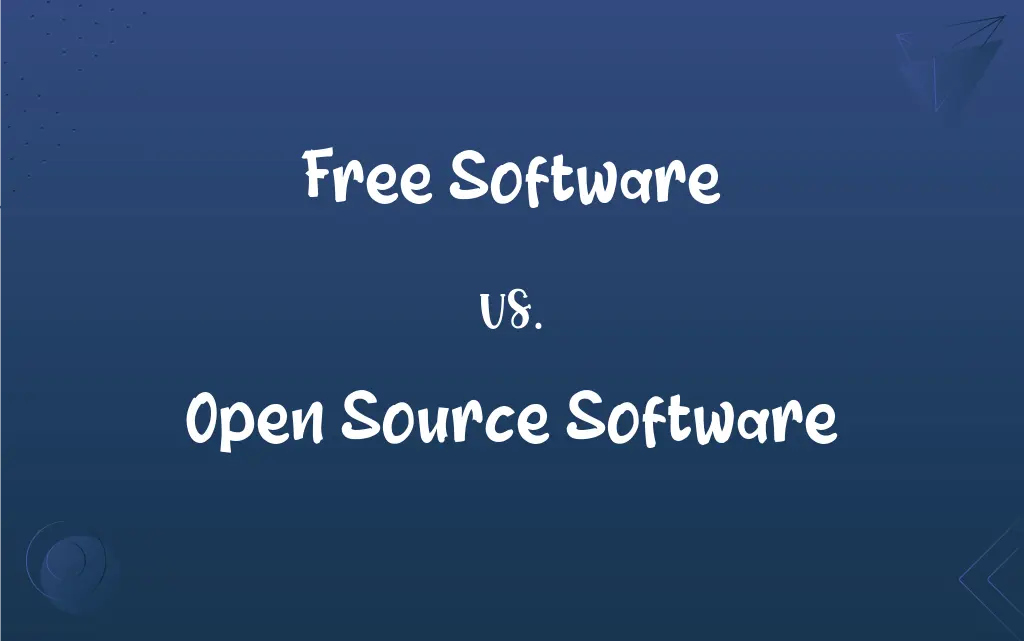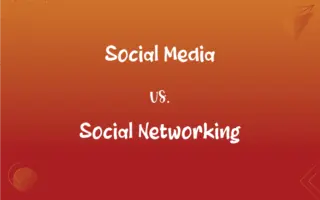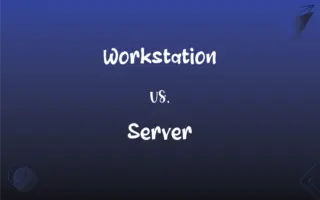Free Software vs. Open Source Software: What's the Difference?
Edited by Janet White || By Harlon Moss || Updated on October 11, 2023
Free software prioritizes users' freedom to use, modify, and distribute, while open source software focuses on the accessibility and collaborative enhancement of the source code.

Key Differences
Free software revolves around the principles of user freedom. The core tenets of free software are that users have the freedom to run, study, modify, and distribute the software as they wish. This does not necessarily mean the software is available without cost, although it often might be. Free software seeks to grant users unrestricted access and control over the software, allowing them to use it for any purpose, understand how it works, adapt it to their needs, and share with others.
Open source software, on the other hand, emphasizes the availability of the source code to the general public. The primary criterion is that the source code must be publicly available, meaning anyone can inspect, enhance, and debug it. Open source software also encourages collaborative development, allowing anyone to contribute to the improvement of the software. Thus, open source software can be developed in a public, collaborative manner.
In a nuanced perspective, free software and open source software might seem akin due to their overlapping ideologies but they are distinct in their core philosophies. Free software is deeply rooted in moral and ethical principles regarding user freedom. It adheres strictly to ensuring that software does not restrict users' freedom to control it and share it. It is vital to comprehend that "free" refers to freedom, not price.
Contrastingly, open source software adopts a more pragmatic approach. It does not inherently revolve around moral principles but rather the practical benefits of a collaborative, open development model. Open source doesn’t necessarily mean the software is free in price or provides total freedom in use, but that the source code is available for view, modification, and distribution.
Both free software and open source software have their distinct paradigms, but often they intersect and many software projects can be considered both free software and open source. The terms are frequently used interchangeably due to their overlapping domains but an informed stance requires recognizing their unique philosophies and origin.
ADVERTISEMENT
Comparison Chart
Philosophy
Centers around user freedoms to use, modify, and distribute.
Prioritizes open, collaborative development and code visibility.
Pricing
Not necessarily zero-cost; "free" pertains to freedom.
Can be either free or paid while maintaining open code access.
Modification & Redistribution
Permits user modifications and redistribution without restriction.
Allows code modification but may have restrictions on distribution.
Accessibility
Can be both open source or have restricted source code access.
Source code must be accessible to all.
Usage Restrictions
No restrictions on how the software can be used or deployed.
Might have limitations based on licensing models.
ADVERTISEMENT
Free Software and Open Source Software Definitions
Free Software
Free software emphasizes four user freedoms: to use, study, modify, and distribute the software.
Firefox is labeled free software, allowing users to explore its source code, modify it, and distribute their own versions.
Open Source Software
Open source software is not always free software, as it might impose certain restrictions on the distribution of modified code.
Red Hat Enterprise Linux is open source software but is not considered entirely free due to its subscription model.
Free Software
Free software can be offered at no cost or can be commercially sold but always provides user freedoms.
While Debian is available at no cost, it still qualifies as free software due to the liberties granted to users regarding its use and distribution.
Open Source Software
Open source software can be developed in a decentralized fashion, leveraging the collective expertise of developers from various backgrounds.
Git, an open source software, is continually enhanced and debugged by a diverse community of developers.
Free Software
Free software must allow for redistribution along with any modifications under the same user freedoms.
GNU Emacs, while open to alterations, mandates that any modified versions should also be freely available, embodying the spirit of free software.
Open Source Software
Open source software enables a collaborative development model, inviting global contributions to the codebase.
Linux, being open source software, has developers around the world contributing to its development and enhancement.
Free Software
Free software can be proprietary if it restricts any of the defined user freedoms.
Even if a platform is gratis but restricts code modifications, it does not align with the definition of free software.
Open Source Software
Open source software may be freely available, or it might be subject to licensing fees, despite its accessible source code.
Android is open source software that, while freely available, allows manufacturers to implement it under various licensing terms.
Free Software
Free software allows users unbridled use, unrestricted access to its source code, and freedom to distribute it.
The Linux operating system is considered free software because users can freely access, modify, and share its source code.
Open Source Software
Open source software is characterized by publicly accessible source code that can be viewed and modified by anyone.
Apache HTTP Server is open source software, allowing developers worldwide to review and enhance its code.
FAQs
Can free software be open source?
Yes, free software can be open source if its free use, modification, and distribution also ensure open access to its source code.
What is free software?
Free software is software that grants users the freedom to use, modify, and distribute it.
Why might a business choose open source software?
To leverage community-driven development, reduce software costs, and increase flexibility and innovation.
How does open source software benefit developers?
It enables collaborative development, code scrutiny, and collective problem-solving, enhancing software quality and security.
Can free software restrict modifications?
No, free software allows unrestricted modifications and sharing of the modified software.
Can open source software be used for commercial purposes?
Yes, it can be utilized for commercial purposes, and proprietary services can be built around it.
What defines open source software?
Open source software ensures the source code is available to the public for view and modification.
Can open source software be proprietary?
No, proprietary software restricts access to its source code, conflicting with open source principles.
How is open source software developed?
Through a collaborative approach where developers globally can contribute to code development, debugging, and enhancement.
Why might developers choose to create free software?
To ensure user freedoms, promote collaborative development, and potentially build a user community around the software.
Is it mandatory to share modifications in free software?
It depends on the license, but typically, free software allows sharing of modified versions.
Are there usage restrictions for free software?
No, free software allows users to use the software for any purpose without restrictions.
How does free software ensure user freedom?
By allowing users to use, study, modify, and distribute the software without restriction.
Can free software have a closed source?
No, free software requires that the source code be available to ensure users can study and modify it.
Can open source software restrict redistribution?
Some open source licenses may impose restrictions or obligations regarding redistribution and disclosure of the modified code.
Is free software always free of cost?
No, "free" refers to freedom, not price; free software can be sold commercially.
Can open source software be sold?
Yes, open source software can be commercially sold while maintaining open access to its source code.
Are there licensing models for open source software?
Yes, various licenses like MIT, Apache, and GPL are used in open source software.
Can free software be copyrighted?
Yes, free software can be copyrighted to ensure that user freedoms are preserved in redistribution.
Is all open source software also free software?
Not always, as open source software might impose restrictions that conflict with the freedoms defined in free software.
About Author
Written by
Harlon MossHarlon is a seasoned quality moderator and accomplished content writer for Difference Wiki. An alumnus of the prestigious University of California, he earned his degree in Computer Science. Leveraging his academic background, Harlon brings a meticulous and informed perspective to his work, ensuring content accuracy and excellence.
Edited by
Janet WhiteJanet White has been an esteemed writer and blogger for Difference Wiki. Holding a Master's degree in Science and Medical Journalism from the prestigious Boston University, she has consistently demonstrated her expertise and passion for her field. When she's not immersed in her work, Janet relishes her time exercising, delving into a good book, and cherishing moments with friends and family.































































